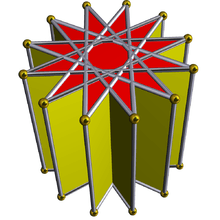Dodecagram
| Regular dodecagram | |
|---|---|
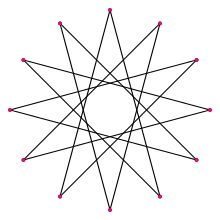 A regular dodecagram | |
| Type | Regular star polygon |
| Edges and vertices | 12 |
| Schläfli symbol |
{12/5} t{6/5} |
| Coxeter diagram |
|
| Symmetry group | Dihedral (D12) |
| Internal angle (degrees) | 30° |
| Dual polygon | self |
| Properties | star, cyclic, equilateral, isogonal, isotoxal |
A dodecagram is a star polygon that has 12 vertices. There is one regular form: {12/5}. A regular dodecagram has the same vertex arrangement as a regular dodecagon, which may be regarded as {12/1}.
The name dodecagram combine a numeral prefix, dodeca-, with the Greek suffix -gram. The -gram suffix derives from γραμμῆς (grammēs) meaning a line.[1]
Isogonal variations
A regular dodecagram can be seen as a quasitruncated hexagon, t{6/5}={12/5}. Other isogonal (vertex-transitive) variations with equal spaced vertices can be constructed with two edge lengths.
 t{6} |
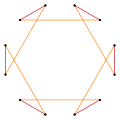 |
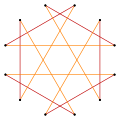 |
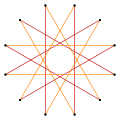 t{6/5}={12/5} |
Dodecagrams as compounds
There are four regular dodecagram star figures, {12/2}=2{6}, {12/3}=3{4}, {12/4}=4{3}, and {12/6}=6{2}. The first is a compound of two hexagons, the second is a compound of three squares, the third is a compound of four triangles, and the fourth is a compound of six straight-sided digons.
.svg.png) 2{6} |
.svg.png) 3{4} |
.svg.png) 4{3} |
.svg.png) 6{2} |
Complete graph
Superimposing all the dodecagons and dodecagrams on each other – including the degenerate compound of six digons (line segments), {12/6} – produces the complete graph K12.
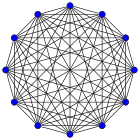
Regular dodecagrams in polyhedra
Dodecagrams can also be incorporated into uniform polyhedra. Below are the three prismatic uniform polyhedra containing regular dodecagrams.
See also
References
- Grünbaum, B. and G.C. Shephard; Tilings and Patterns, New York: W. H. Freeman & Co., (1987), ISBN 0-7167-1193-1.
- Grünbaum, B.; Polyhedra with Hollow Faces, Proc of NATO-ASI Conference on Polytopes ... etc. (Toronto 1993), ed T. Bisztriczky et al., Kluwer Academic (1994) pp. 43–70.
- John H. Conway, Heidi Burgiel, Chaim Goodman-Strass, The Symmetries of Things 2008, ISBN 978-1-56881-220-5 (Chapter 26. pp. 404: Regular star-polytopes Dimension 2)
